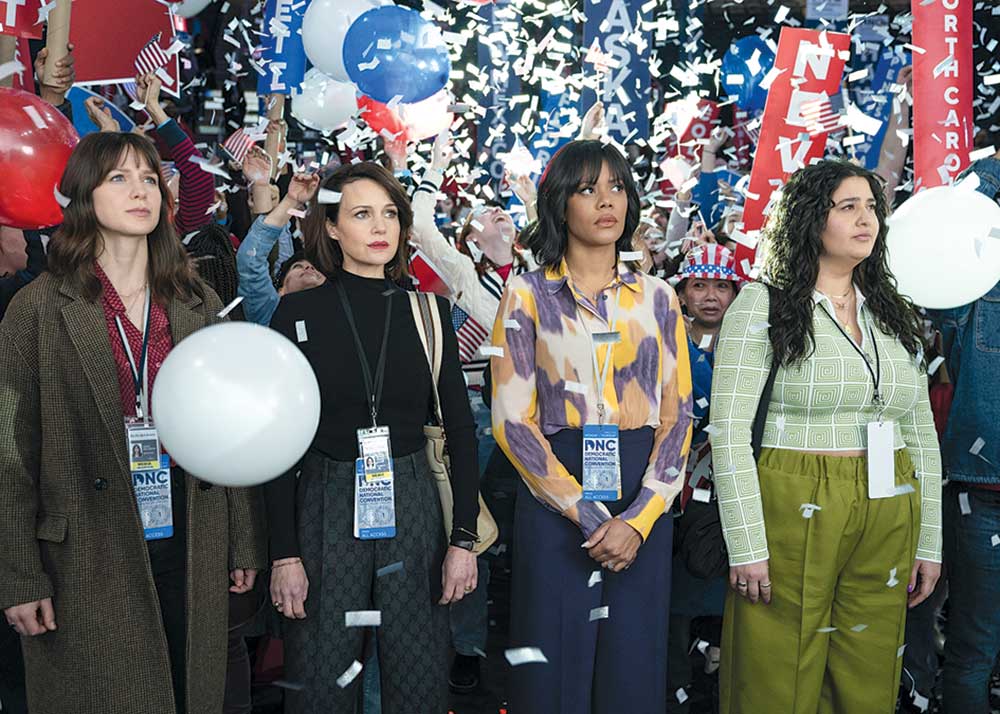A disparate group of female journalists covering a presidential campaign bond in The Girls on the Bus
In her memoir, Chasing Hillary, New York Times journalist Amy Chozick detailed how the terse relationship between Hillary Clinton and the media affected the outcome of the elections in 2008 and 2016. Chozick, who makes it clear that she started out fond of Clinton, goes through the wringer with both the candidate and her staff on the campaign trail. Clinton — who feels she is held to impossible standards — has an innate distrust of the media, and the contempt she feels towards them is often reflected in their reporting. In her book, Chozick wants the reader to know she feels bad about her role in Clinton’s failure to become the first female president of the USA — especially in light of what ended up happening instead.

Chozick’s story now comes to the screen in the form of The Girls on the Bus, a fictionalized series about four female journalists on the campaign trail for the U.S. primary election. Portraying a version of Chozick is Melissa Benoist (Supergirl) as Sadie McCarthy, an ambitious young reporter at a legacy newspaper. Carla Gugino (The Fall of the House of Usher) plays Grace, an experienced journalist who is trying to balance breaking news and being a present parent to her college-age daughter. Christina Elmore (Insecure) plays a Black reporter for a conservative TV network. And then there is Lola, the TikTok star covering the campaign for Gen Z, played by Natasha Behnam (Mayans M.C.).

The four women, who represent different generations, political ideologies and professional approaches, form a friendship that becomes the basis of the series. “I loved that these women never let their ideological positions get in the way,” says Elmore. “In fact, it only helped to deepen the conversations that they have. Even the debates that they had were done with care, love and tenderness. I love seeing that, because those are the kind of friendships I have and those are the kind of friendships I want to nurture.” For Gugino, the relationship between the lead characters was the reason she signed on to the 10-episode series. “It was the thing that was the most resonant with me when I read it,” she says. “We are in a moment where our world is so agitated and people are being forced to take sides, and it creates this kind of reactivity that is not conducive at all to conversation or communication. So, to me, the fact that ‘we are all in this together’ supersedes those beliefs, was the main reason that I found this show to be a story worth telling.”
What was of equal importance to Benoist, who is also an exec producer on the show, was demonstrating the job of a journalist without relying on stereotypes that pop culture has often leaned into. “There’s been a big trope that female journalists sleep with their sources to get information, and that is a trope that we definitely wanted to not give into. Your career would be over. Done,” she says. “These four are all very ethical. They make mistakes. They’re not perfect. They’re human, but they’re ethical. They care about trying to do the right thing.” Benoist also felt a responsibility toward Chozick and her career path. “It was the deepest and most emotional process I’ve gotten to do,” she reflects. “One of the things that I found challenging was the character relationship between Sadie and her editor [played by Griffin Dunne] that I think was very reminiscent of Amy Chozick and one of her mentors. That was a challenge, to remain as truthful as possible to what Amy’s true feelings were, so I really wanted to do right by her in that regard.”
Though based on real-life people and political events, trying to find parallels in this particular world created by Chozick and The Vampire Diaries producer Julie Plec was not something the cast engaged in. “I loved that it wasn’t a world that I needed to prepare for by looking at our own current political landscape or by having to figure out exactly who the avatar for this character was,” says Elmore. “Amy’s encountered so many kinds of politicians and journalists that all of our characters are an amalgam of lots of folks. But it’s such a fun thing to enter into a world in which you actually learn the mechanics of it and see things that you’ve taken for granted.” The Girls on the Bus may be a glimpse into a fascinating profession, but the crux of the series goes beyond just scooping your colleagues. “Politics can be quite a circus, as is journalism, so it’s a really fun backdrop for the show.” says Elmore. “There’s this sort of professional wrestling element to it too, which is that these people are theoretically opponents, but they know the parts that they’re playing, and ultimately at the end of the day, they’re going to go have a drink at the bar and talk about all of it.”
The Girls on the Bus airs Thursday, April 4, on Crave1
